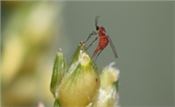Sorghum Midge – To Spray Or Not To Spray

DR. SCOTT STEWART
JACKSON, TENN.
Economically damaging infestations of sorghum midge are not very common, particularly on early planted milo. However, high populations can cause substantial yield loss. This is a tiny orange fly, and because the larvae develop inside the seed husks. Thus, your only chance of controlling infestations is to control the adult midge. With increased acreage of sorghum, it is understandable the folks are nervous about scouting for this pest.
I want to reiterate that I have only seen serious midge damage in a few fields during my career, but that does not mean to take this pest lightly. Below I have outlined a little information about sorghum midge biology. There is also a good publication by Mississippi State University on the biology and control of the sorghum midge.
• Adult females live just 1 day and lays her eggs in eggs inside the seed husks. Thus, this insect is only a pest during bloom.
• The larvae feed on the developing seeds causing them to dry up and die.
• The entire life cycle lasts 14-18 days.
• Johnsongrass is an alternative host. Minimizing Johnsongrass in and around the field can help reduce infestation levels.
A bag technique is often suggested for scouting midge. For this method, place a clear plastic bag over the blooming head. Lightly shake or hit the head to dislodge adult midges. Quickly remove the bag from the sorghum head and adult midges visible in the bag. I often just patiently look at the heads for the bright orange midges. You can even look at spider webs for hints of infestation.
Treatment is recommended when an average of one midge per grain head is found. You should not begin treatment until 20-30 percent of grain heads are flowering. Often, the worse midge infestations are in fields or parts of fields planted adjacent to earlier maturing milo. Midge populations can build on the early sorghum and migrate to the later heading plants. A week or so difference in heading is no big deal, but be alert if adjacent fields or replanted areas are lagging behind by 10 or more days.
Typically, synthetic pyrethroids such as Baythroid XL, Karate or Mustang Max are used to control sorghum midge. Multiple applications may be needed in fields where head emergence is not uniform or populations are unusually high. Things get complicated if sugarcane aphids are present or looming nearby. Pyrethroid insecticides can flare aphid populations by removing natural enemies. You might consider using Lorsban or its generic equivalents at a rate of 16 oz/acre for midge control if low populations of aphids are present. Lorsban sometime provides at least some control of aphids and may be less likley to flare populations. If sugarcane aphids are numerous, tank-mixing a pyrethroid insecticide with Transform or Sivanto is probably the best choice. Fortunately, sugarcane aphids have not been found yet in Tennessee. They move quickly, but it looks like at least the earlier planted milo will mostly escape aphid infestations.
Note – Products containing bifenthrin, such as Brigade, are not labeled for use in sorghum. Ammo is also not labeled.
Hint – It may help for next year to get some practice. I often see midges on heads emerging from sucker plants around field edges (or from bush-hogged stalks). This is 14-21 days after the majority of the field has flowered. Indeed, this is the only place I can find sorghum midge in most fields. ∆
DR. SCOTT STEWART: IPM Extension Specialist, University of Tennessee